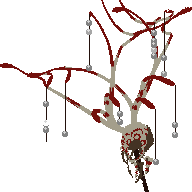
Scavengers, often abbreviated as Scavs, are widespread tribal creatures that are generally seen in groups. They are social creatures that use gestures and body language to communicate with one another, and they are capable of carrying and utilizing weapons in a manner similar to Slugcat.
Scavengers are quadrupedal with long forearms and short legs. They have various types of antlers, horns, and beards, and they may have tails, spines, or frills of varying sizes. They come in a wide range of colors, but most commonly in neutral and desaturated tones. Their eyes can be different colors and shapes, and they may or may not have visible pupils. They are expressive and can exhibit many emotions.
Scavengers can walk, climb, and crawl and are a bit faster than Slugcat in most cases. They do not have the ability to jump; rather, they spontaneously gain vertical momentum when they need to move upwards, which can lead to some unintended physics interactions.
Scavengers can carry and throw weapons, including (but not limited to) ![]() Rocks,
Rocks, ![]() Spears, and
Spears, and ![]() Grenades. They have 3 slots for holding items (2 hands and a "pocket slot" on their side) and can hold up to 3 extra Spears on their back. They are capable of throwing Spears at an angle, meaning they can hit targets slightly above or below them. They also have the ability to dodge objects thrown at them. Each Scavenger has a different level of combat skill determined by individual stats.
Grenades. They have 3 slots for holding items (2 hands and a "pocket slot" on their side) and can hold up to 3 extra Spears on their back. They are capable of throwing Spears at an angle, meaning they can hit targets slightly above or below them. They also have the ability to dodge objects thrown at them. Each Scavenger has a different level of combat skill determined by individual stats.
Scavengers utilize a wide array of body language and gestures to communicate amongst themselves and with Slugcat. Depending on their body lenguage they can communicate their situation and personality. If they hold a Spear in their hand and point it to some other creature, that means that they are scared and are disposed to attack unless they stop being a menace. If they extend their hand to the Slugcat, that means that wants something valuable such as a Pearl that the Slugcat may be holding
Certain objects can be used to trade with Scavengers. Scavengers typically trade more generously and drop more objects if Slugcat's reputation is high. Even as Artificer, Scavengers drop items in 'trade'; this does not affect reputation and they still attempt to kill ![]() Artificer.
Artificer.
Reputation gain increases with the value of the item traded, and at tolls there is a set reputation multiplier for each traded item. Items dropped by Scavengers may be picked up and traded again.
Friendly Scavengers occasionally take Spears from Hunter's back if they do not already have a Spear. This behavior can be disabled via a Remix option.
| Item Value | Item |
| 20 | |
| 10 | |
| 7 | |
| 5 | |
| 4 | |
| 3 | |
| 2 | |
| 1 |
Scavenger Tolls, known as Scavenger Outposts in-code, are rooms in which a group of Scavengers has set up base around a toll post. A sufficient item offer is required before passage through the Toll is allowed. The total value of objects must add up to 10; a single Pearl is sufficient to pass, but any combination of tradable objects may be used. Paying the toll once allows Slugcat to pass freely as many times as wanted until the end of the cycle.
Passing a Scavenger Toll without payment causes Scavengers to become aggressive and decreases reputation. If no Scavengers witness the transgression, then no reputation penalty is incurred.
Any item traded at a toll has a reputation increase multiplier on its trading value. Taking items from within a certain radius around the toll post is considered stealing and may aggravate the Scavengers. Toll Scavengers are always neutral towards Slugcats (except Artificer, who they are always aggressive towards), regardless of current standing, unless provoked.
If reputation is high enough ( higher than 50), Scavenger Tolls can be passed for free at a small cost to global reputation. At very high levels (higher than 90), Scavenger Tolls can be passed for free without any reputation loss.
Two Tolls can be found in ![]() Garbage Wastes, and one in
Garbage Wastes, and one in ![]() Outskirts,
Outskirts, ![]() Farm Arrays,
Farm Arrays, ![]() Outer Expanse, and
Outer Expanse, and ![]() Undergrowth.
Undergrowth.
Scavenger Merchants are Scavengers with unique behaviors that can be found in ![]() Garbage Wastes,
Garbage Wastes, ![]() Shaded Citadel,
Shaded Citadel, ![]() Sky Islands, and
Sky Islands, and ![]() Subterranean in special rooms decorated with Scavenger graffiti and Lanterns on long pikes. Merchants usually stay inside this room unless scared away and are capable of fighting if unable to escape.
Subterranean in special rooms decorated with Scavenger graffiti and Lanterns on long pikes. Merchants usually stay inside this room unless scared away and are capable of fighting if unable to escape.
Scavenger Merchants are usually fully stocked with ![]() Lanterns (other than in Sky Islands),
Lanterns (other than in Sky Islands), ![]() Mushrooms,
Mushrooms, ![]() Grenades, and most commonly, Spears or Explosive Spears. They are also more docile and more willing to trade. Scavenger Merchants still value items equally to regular Scavengers, however. As with other Scavengers, Merchants trade more items at higher reputation.
Grenades, and most commonly, Spears or Explosive Spears. They are also more docile and more willing to trade. Scavenger Merchants still value items equally to regular Scavengers, however. As with other Scavengers, Merchants trade more items at higher reputation.
Once their inventory is cleared out, Scavenger Merchants return to their den to restock, meaning they never run out of items to trade.
Scavenger Treasuries are rooms, often with hidden entrances surrounded by Scavenger graffiti, that contain a large amount of Spears, Explosives, ![]() Pearls, and occasionally other items like Lanterns that randomly spawn each cycle. These are the only rooms with naturally respawning Pearls. Nomadic groups of Scavengers visit these rooms to stock up on weapons.
Pearls, and occasionally other items like Lanterns that randomly spawn each cycle. These are the only rooms with naturally respawning Pearls. Nomadic groups of Scavengers visit these rooms to stock up on weapons.
Taking an item incurs a reputation penalty if Slugcat has less than 90 reputation, applied once for every conscious Scavenger in the treasury. The reputation penalty is a linear extrapolation based on Slugcat's current reputation, with a penalty of -30 if Slugcat has -50 reputation or less and 0 if Slugcat has 90 reputation or more. Stealing Pearls from Treasuries and trading them back to Scavengers can be an efficient way of gaining reputation, since no reputation is lost if there are no witnesses.
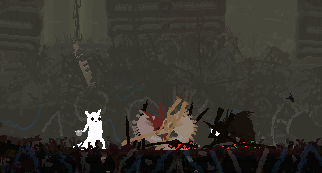
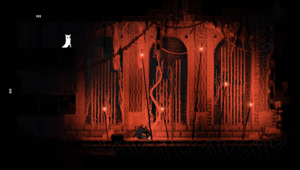
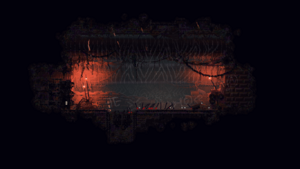
Scavengers are commonly seen in neutral, earthy tones, but they are capable of exhibiting any color. They usually have 3-6 colors depending on their physical traits: body color, stomach color, head/gradient color, antler/horn accent, eye color, and pupil color. These may sometimes overlap (e.g. Scavengers with the same antler/horn accent and stomach color are common).
Their main features can be broken down into a few categories: head decoration, stomach patch, gradients and back decoration. Scavengers can have a few variations of antlers in different positions on their heads, as well as 'beards' and back frills of various shapes and sizes.
Aggression impacts dominance.
Bravery impacts aggression, dominance and nervousness.
Dominance does not impact any other personality modifiers.
Energy impacts aggression, dominance, and nervous.
Nervous does not impact any other personality modifiers.
Sympathy impacts aggression.
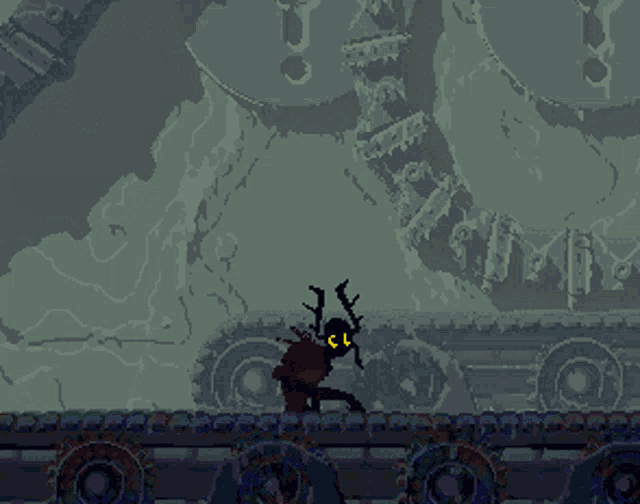
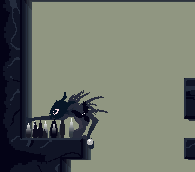
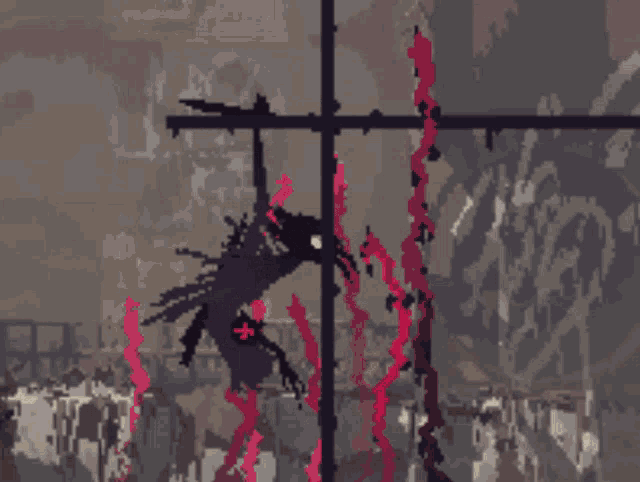
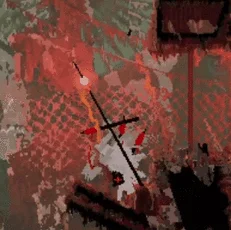
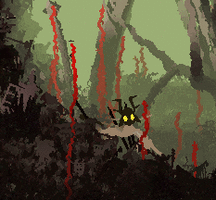
Scavenger behavior has the most visible variation under the Reputation system. There is both a local reputation value for the Scavengers in a given region, and a global reputation value, the latter of which can be observed ![]() through The Chieftain. Unlike other creatures with reputation, local actions affect the global reputation scale greatly. Progress for the Chieftain passage is usually mapped on the range 10-80 of global reputation.
through The Chieftain. Unlike other creatures with reputation, local actions affect the global reputation scale greatly. Progress for the Chieftain passage is usually mapped on the range 10-80 of global reputation.
Reputation with Scavengers can be gained by trading with them and saving them from harm. As reputation rises, Scavengers become less aggressive, may attempt to save Slugcat from harm, and, once trusted enough, allow Slugcat to pass through Tolls and take items from treasuries without repercussions. The benefits of good reputation do not extend to tamed ![]() Lizards, and Scavengers remain aggressive towards them.
Lizards, and Scavengers remain aggressive towards them.
Inversely, if repeatedly stolen from, harmed, and ignored when in danger, reputation is lowered and Scavengers become more aggressive. If infractions are committed repeatedly, reputation can eventually drop to a point where Scavengers actively seek Slugcat out and send kill-squads to their general location.
Along with global and regional reputation, each individual Scavenger has their own reputation with Slugcat; if care is taken to be friendly to a particular Scavenger, they may be more inclined to follow Slugcat and trade generously compared to others in their group. This can also lead to random reputation changes when the leader of a group dies and a new Scavenger with a differing opinion takes over.
Scavenger reputation is measured on a scale of -100 to 100 and may only change by a maximum of +/-50 each cycle. Reputation gain is linear above 0 but becomes exponentially smaller as reputation goes into the negatives. When reputation is below 0, a small amount of reputation is gained passively each cycle provided no interactions with Scavengers are had. This passive increase scales up the closer reputation is to 0, maxing out at +10 reputation per cycle. Reputation loss is multiplied based on the number of witnesses, but reputation gain is not, unless saving a Scavenger from a threat.
Depending on Slugcat's reputation, Scavengers become more or less aggressive toward Slugcat while they are holding a Pearl. With good reputation, Scavengers tend to become friendlier if Slugcat has a Pearl, while Scavengers who are already hostile or fearful may become more likely to attack instead.
At a reputation bigger than 50 , Tolls can be passed without paying at the cost of reputation.
At a reputation bigger than 90 , items may be freely taken from Treasuries, and Tolls may be passed for free without reputation loss.
As with all reputation values, Scavenger reputation is artificially lowered for all Slugcats in ![]() Subterranean.
Subterranean.